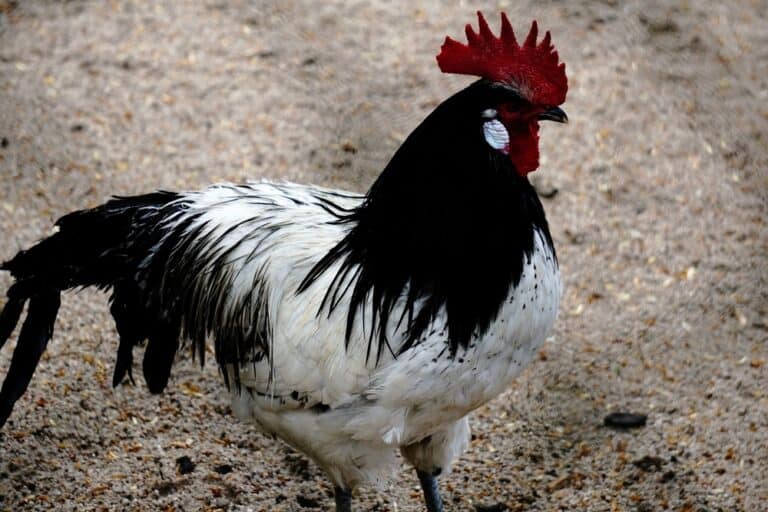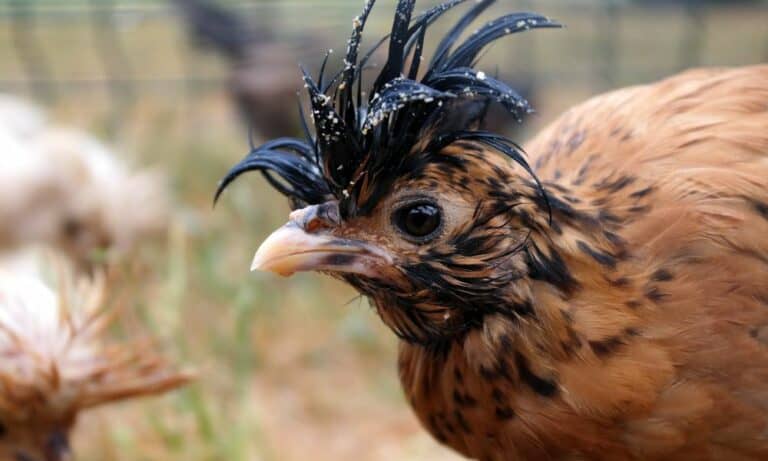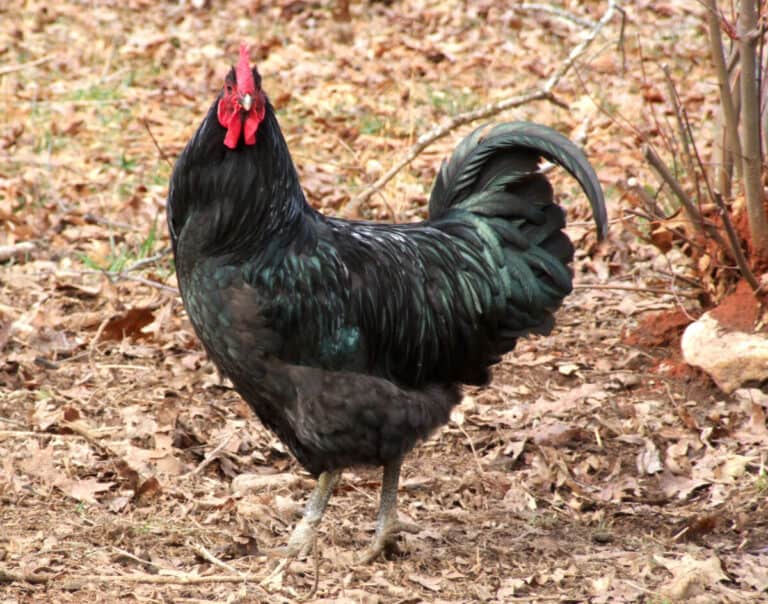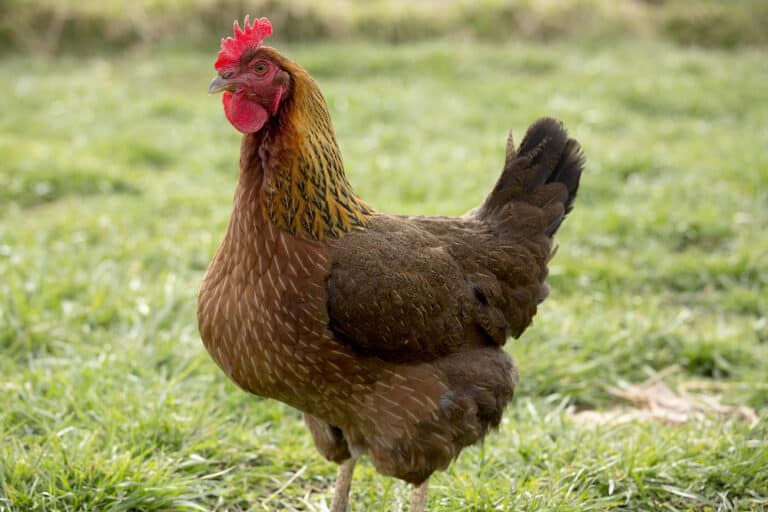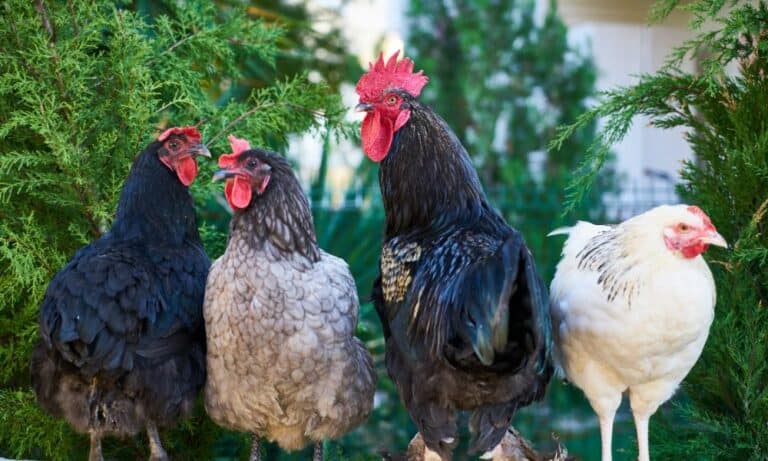Aseel chickens, sometimes called Asil chickens, are an ancient breed that originated in India. The first birds came to Europe in the 1840s, while the American Poultry Association’ recognized them as a separate breed only in 1981.
In the past, highly aggressive roosters were kept for cockfighting, but that has changed over time. Nowadays, most people worldwide keep them as ornamental birds and consider them the most vital existing game birds.
Aseel chicken (Asil, Azeel, Asli) |
|
| Origin | Pakistan and India |
| Category | Game birds |
| Breed size | Large |
| Broodiness | High |
| Rarity | Critical (pure-breed chickens are incredibly rare) |
| Varieties | Pure Assel breed, Amroha, Chitta, Bhaingam, Kagar, Kulang, Kilimooku, Heera, Lasani, Yarkin, Madras, Mushka, Mianwali, Parrot beak, Peela, Reza, Teekar, Thai, Shamo, Sindhi |
| Climate tolerance | All climates, particularly heat tolerant |
| Care level | Free range but bears confinement well when special care is included |
| Lifespan | 10 years |
| Height | Cocks – 24 to 26 inches (61 – 66 cm)Hens – 20 to 22 inches (51 – 56 cm) |
| Standard weight | Cock – 6.60 to 13 pounds (3 – 6 kg)Hen – 5.50 to 6.60 pounds (2.5 – 3 kg) |
| Reza weight | Cock – 4 to 6 pounds (1.8 – 2.7 kg)Hen – 3 to 5 pounds (1.35 – 2.25 kg) |
| Bantam weight | Cock – 2.4 pounds (1.1 kg)Hen – 2 pounds (900 g) |
| Feather color | White, red spangled, Pyle, duckwing, brown, blue-breasted red, black-breasted red, and black |
| Skin color | White or yellow |
| Comb type | Sizable, pea |
| Leg color | Yellow |
| Leg type | Clean, without feathers or feathered, depending on the variety |
| Purpose | Meat and cock-fighting in the pastMeat, pets, and ornamental poultry nowadays |
| Egg size | Small to medium |
| Egg color | White, cream, tinted, and light brown |
| Annual egg production | 6 to 40 |
| Sitter | yes |
| Flying ability | Not very flighty but can fly when needed |
| Temperament | Friendly with humans but highly aggressive with other birds. They are intelligent and quiet but difficult to keep in flocks |
| Beginner friendly | no |
| Achieving full size | 9 to 10 months |
| Start of egg production | 5 to 6 months |
| Beginning of the meat harvest | 27 to 50 weeks |
Aseel History

Once you start researching, you can discover a long and rich history behind unique Aseel chickens. Still, it is practically impossible to precisely determine the period of their appearance on the historical scene.
Many experts believe the breed was created thousands of years ago, making it one of the oldest worldwide. The first document describing these chickens and their fights is the Codes of Manu, dating between 1280 and 900 BC.
It was an Indian document, but there was no note of whether the breed initially occurred in India or on the territory of modern-day Pakistan.
The breed name meant THOROUGHBRED or PURE in Arabic and HIGH CASTE or HIGH-BORN in Hindi. Such a name was a sign of deep respect, although its primary purpose was cockfighting.
The first Aseel chickens came to Britain around 1847, while Dr. H.P. Clarke brought them to the US from Lucknow, India, in 1887. The arrival of new birds to American soil was organized again when Dr. D.S. Newill imported several chickens directly from India in 1931.
The American Poultry Association recognized some varieties in 1981 and included them in the Standard of Perfection. In the past, these chickens were popular in Holland, but the outlawing of cockfighting resulted in declining popularity.
According to the Livestock Conservancy Priority List, the breed is considered endangered nowadays. However, these chickens are still widespread in Pakistan and a few Indian states.
Aseel Chicken Traits
Aseel chickens were bred for cockfighting for centuries, but farmers highly appreciate their nutritious and yummy meat nowadays. This poultry type has numerous variations, and all are beautiful, protective, and aggressive.
General characteristics
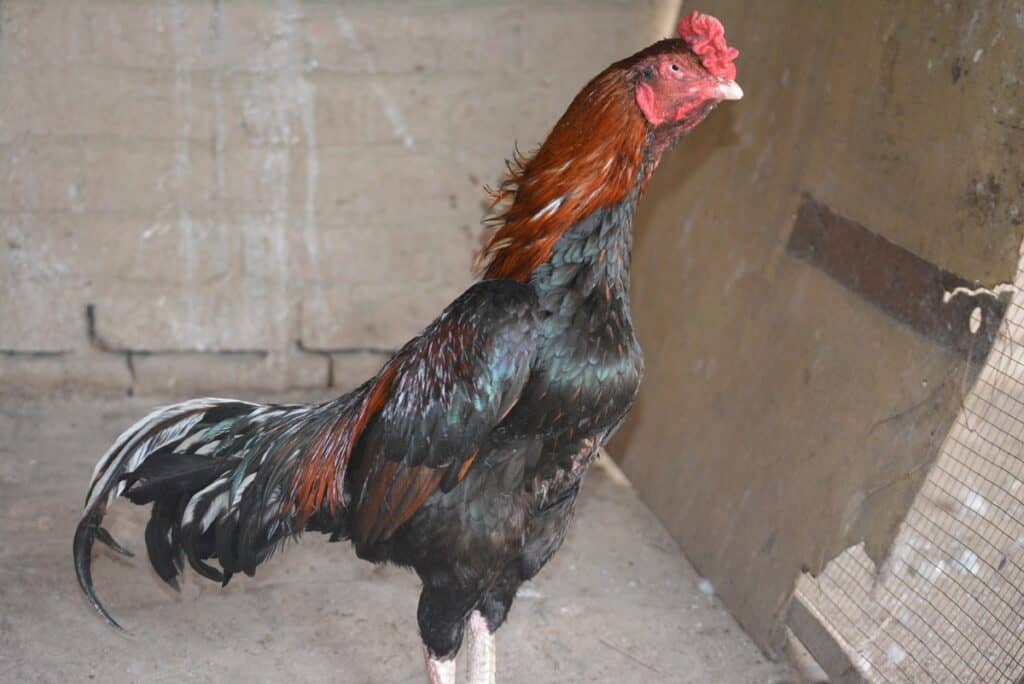
Aseel chickens are common game birds in Southeast Asia, primarily Pakistan and India. Nowadays, this unique breed exists in a few regions, including:
- Uttar Pradesh
- Andhra Pradesh
- Tamil Nadu
- South Punjab
- Rajasthan
- West Bengal
- Odisha
Aseel chickens are considered a cultural symbol in these countries and a crucial part of religious ceremonies and traditional cultural events. Nowadays, they are protected by law as a national treasure, and you can find numerous artwork types using this poultry as a motif.
Appearance
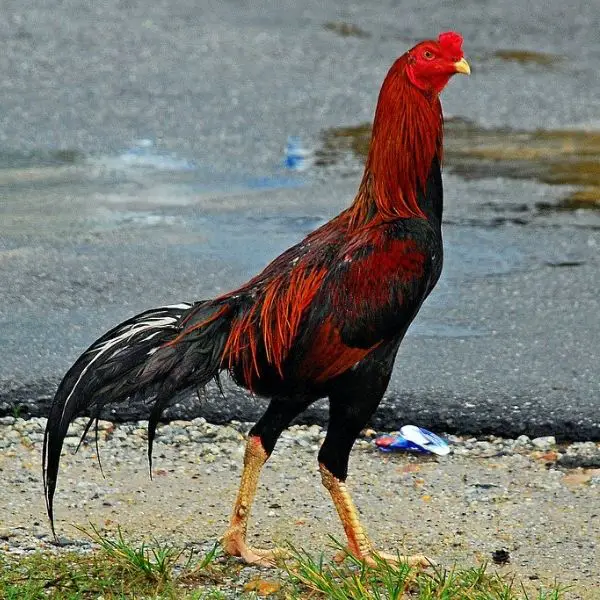
Aseel chickens have compact and muscular bodies, making them heavier than they appear at first glance. They have a recognizable upright posture and hard, short feathers tightly held to the body.
You can quickly recognize their small round skulls with fierce, neatly centered, pale eyes, a large comb, and hawk-like beaks. Their legs are short, yellow-colored, and with or without feathers, depending on the type.
Besides numerous variations with different looks, you can also find a rare native Pure Aseel breed without any genetic modifications. These chickens have white eyes, small beaks, and tiny ears. Their wings and thighs are sizable, their breasts broad, and they always come with dropping tails.
Height and weight
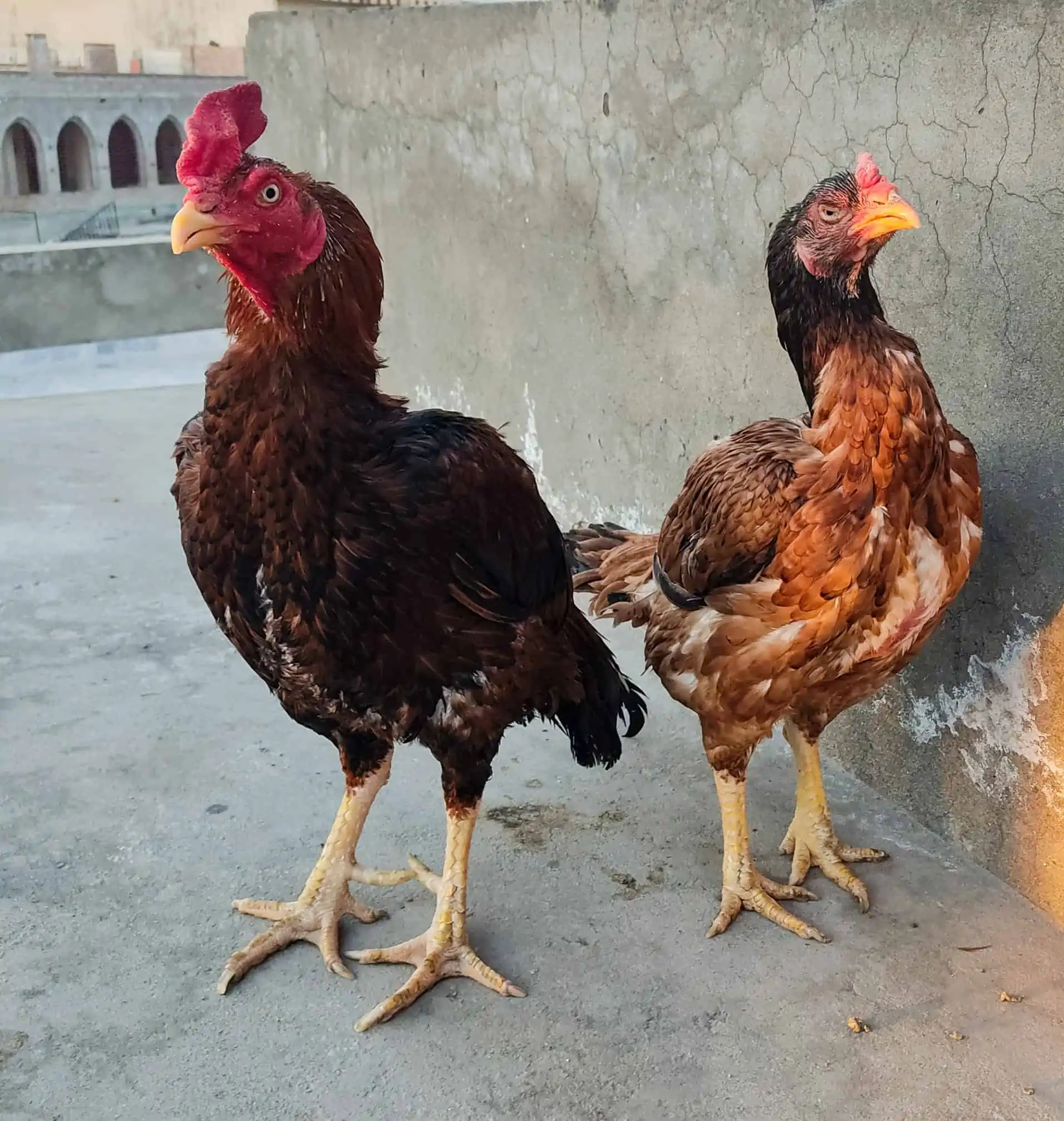
Aseel chickens are typically tall, and roosters can reach 24 to 26 inches (61 – 66 cm) in height. Hens are slightly shorter and approximately 20 to 22 inches (51 – 56 cm) high.
Standard varieties are the heaviest, and cocks can be 6.60 to 13 pounds (3 – 6 kg) heavy when kept well. A typical weight for hens is 5.50 to 6.60 pounds (2.5 – 3 kg). On the other hand, small bantam chickens reach only 2 to 2.4 pounds (900 g – 1.1 kg), depending on gender.
The most popular Reza variety is somewhere in between. Roosters are 4 to 6 pounds (1.8 – 2.7 kg) heavy, while hens typically weigh 3 to 5 pounds (1.35 – 2.25 kg).
Color

Most Aseel chickens have mixed-color, including white, red, grey, and black feathers, with the most appreciated:
- White (Heera)
- Golden-red (Peela)
- Light red (Reza)
- Brown (Teekar)
- Black and white-silver (Chitta)
- Black and red (Yarkin and Amroha)
- Black (Kagar)
- Black with green shades (Mushka and Shamo)
Remember that their coloration primarily depends on their breeding history and genetics. Therefore, you should choose carefully when the feather shade is one of the crucial traits you are looking for.
Behavior

Aseel chickens have been bred for fighting purposes for centuries, thanks to their well-known aggressive behavior. You can expect cocks to be highly territorial and form powerful bonds with their humans. Consequently, they will fiercely protect their owners and members of their families.
Since these birds are intelligent, they quickly understand their tasks. So, you can teach your chickens to guard and hunt successfully like watchdogs. If you are patient enough, you can make them fierce and uncompromising guardians of your kids.
Keep males away from other poultry to prevent brawls that often end in blood and even with a fatal outcome. Since roosters are often the most hostile to the members of their own breed, you should never keep two in the same yard.
Purpose
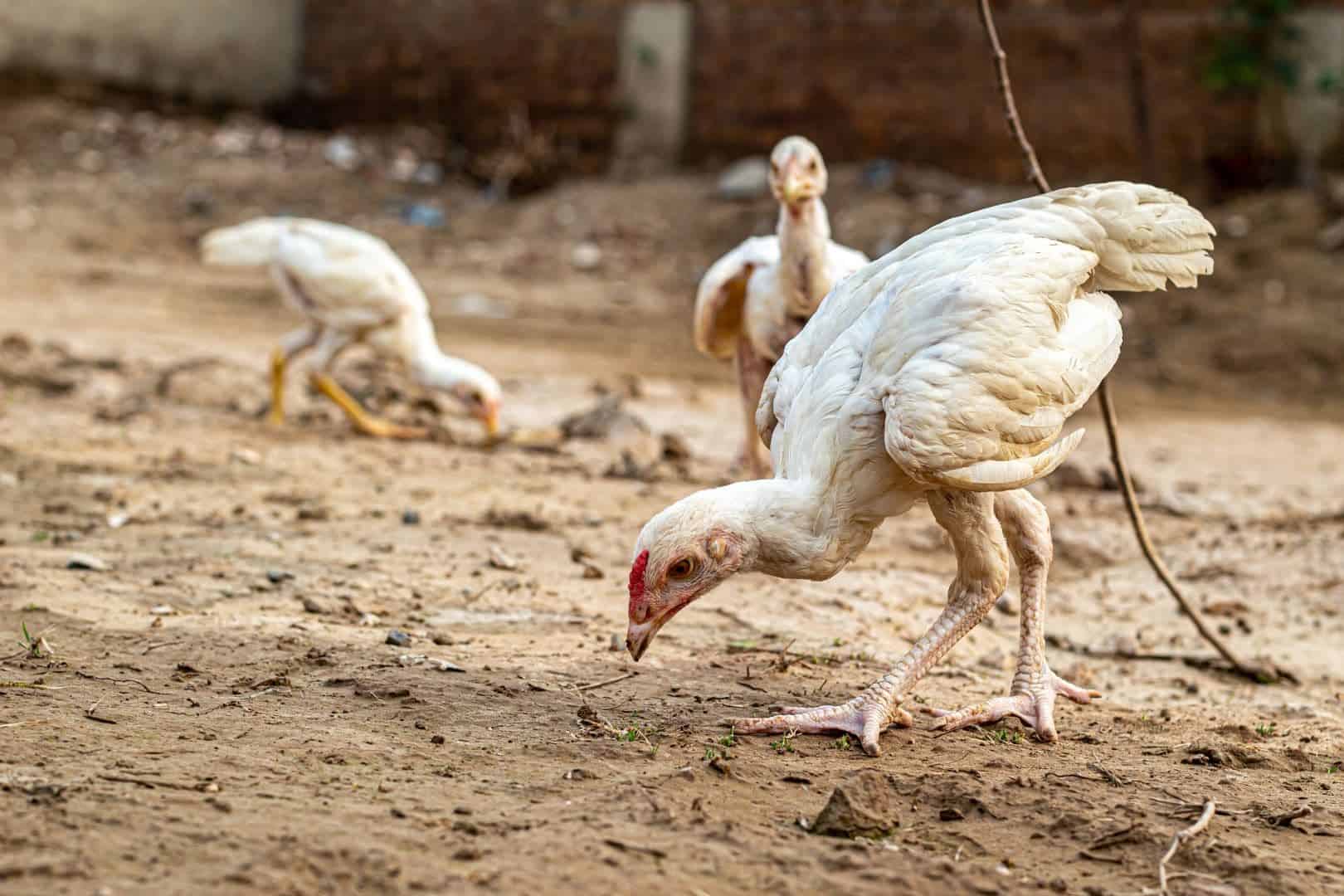
Aseel hens are seasonal layers, but their level of production is low. You can expect them to lay only 6 to 40 cream eggs a year, depending on the variety. Once they get chicks, they become excellent and protective moms.
On the other hand, their meat is appreciated and incredibly delicious, so many farmers keep this poultry type for this purpose. Thanks to the high protein levels and low-fat percentage, it is also highly nutritious.
Breeders often use these slow-growing chickens as a crossbreeding base thanks to their strong genetics. That way, they produce unique variations with ultimate traits.
Health and Care
The best way to organize Aseel chickens’ housing is to provide a shelter according to their temperament, size, and weather conditions in the region where you live. An average bird requires 6 to 8 sq ft (0.55 – 0.75 m2) in a coop and plenty of space outdoors for moving, exploring, and exercising.
Your poultry can tolerate a wide range of humidity and temperatures, but you should protect it from harsh weather. They can’t stand too hot summer days and extreme coldness during the winter. Provide dry and comfortable bedding and pay particular attention to the ventilation to prevent building-up moisture and ammonia.
This breed has unique dietary needs because of its specific muscular bodies. Therefore, providing quality food with 18 to 20% protein two to three times a day, adequate mineral supplementation, and free access to water is crucial.
Be careful with treats and never offer feed rich in sugar and fat to prevent overweight. Your Aseel chickens will enjoy cooked rice, fresh fruits and veggies, and oatmeal.
Aseel chickens are healthy and are never susceptible to common poultry diseases. The only thing to think of is to remove their spurs that leave fatal wounds during cockfighting. In sporadic cases, you can find flocks suffering from the following:
- Vitamin A deficiency
- Bird flu
- Coccidiosis
- Chicken Pox
Summary
Aseel chickens are an aggressive breed, and people have used these feisty fighters for cockfighting for centuries. In modern times, people keep flocks of these elegant and intelligent game birds as pets since they are friendly when separated from each other.
Even though hens are not particularly productive, with only 6 to 40 produced eggs annually, some farmers enjoy having such beautiful chickens around their houses.

